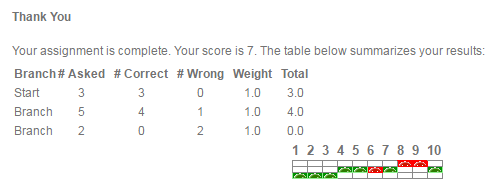
Educators have always known that different students in their classes have different needs. One of their biggest challenges is how to meet the individual needs of each student while facing the inevitable constraints of time, money, and resources. If a student fails to learn one idea properly, it will have a large impact on their future learning, but with large classes and many concepts to teach, how can an instructor ensure that their students understand?
Technological advances mean that automated testing is now available to help instructors manage part of this challenge. Automated assessment tools enable instructors to give students lots of opportunities to solve problems and get feedback without adding to the instructors’ grading burden. As a result, instructors can help students learn, and identify gaps in their understanding by examining the data on student performance collected by the software.
Adaptive testing takes this idea even further. Not only is the grading automated, but adaptive assessment changes with the students ability – asking them harder or easier questions, walking them through problems step-by-step to identify the point where they are making a mistake, allowing them to show what they know and discover where their weaknesses are. This personalized learning experience means that each student gets the help they need where they need it, at the moment they need it. For instructors, it means they get more refined insights into where their class, and even their individual students, are having problems. This allows the instructor to spend review time more effectively, provide targeted additional homework based on class-wide concerns, and address the needs of individual students seeking help more easily.
The beauty of adaptive questions lies in its ability to address areas of need, without impeding those who have shown a clear understanding of the material being covered. There are a variety of ways questions can be adapted in order to properly show comprehension of the material, and provide the appropriate assistance needed. If a question is answered incorrectly, it might make sense to provide another attempt at the question. Or perhaps it’s more fitting to present a simpler version, before bringing the student back to the original question. Feedback can be given, explaining what needs to be done each step of the way, or hints can be provided after certain number of attempts, or at places where a student is struggling.
Credit can be weighted in relation to how much help or how many attempts were needed to answer correctly. This is another case of how impactful adaptive questions can be. If a student gets a question incorrect, was it due to a simple mistake or a lack of knowledge? These students can now get a grade that correctly reflects their understanding, and get targeted help in areas where they may be lacking, all without leaving the testing environment. The instructor is in full control of how a student moves through a question and how they receive credit for their work.
Entire assignments can adaptive as well. In an adaptive assignment, the selection of the next question in an assignment depends on how the student has done on the previous questions. This ability can be used in a variety of ways, including sorting students into different streams, providing extra reinforcement only when it is needed, and allowing more advanced students to truly show what they are capable of without discouraging less advanced students. Each assignment can have customized criteria, dictating how students are graded, navigation through branches or difficulty levels, and what needs to be accomplished to exit or complete the assignment. Each student moves through the assignment as is most appropriate to their skill level, finding their limits and challenging themselves with questions at the right level for their current abilities.
For example, a student may be moved onto a harder branch after five consecutive correct responses or moved to an easier branch after their third mistake. In this way, all students can demonstrate the extent of their understanding using the same assignment, even if those abilities vary greatly. Instructors get an overview of class performance, obtain information about strengths and weaknesses, and can sort students by their ability levels for placement or extra tutorial sessions.

These types of questions and their ability to properly assess student comprehension is of particular concern for STEM instruction, which has specialized needs and challenges not addressed by many automated assessment systems. Did a student properly understand the concept, or merely understand enough to eliminate all of the incorrect responses in a multiple choice question? If an instructor does not assess certain skills because their assessment system cannot generate or grade the necessary questions, adaptive assessment will simply not be able to help students in that area. Maple T.A. is an assessment system designed especially for courses involving mathematics and provides extensive support for STEM education, as well as its adaptive assessment capabilities, enabling you to provide effective personalized assessment to students in your STEM courses.
The benefits of adaptive testing for the student are clear. Each student has a personalized learning experience that identifies their weaknesses, validates their strengths, and efficiently guides each student to greater understanding. For the instructor, the advantages are also significant – students can resolve gaps in their understanding more easily on their own, and instructors have greater insight into what their students understand and what they don’t. As a result, class time and course materials can be effectively geared to meet the needs of the students, students are more successful, and both students and instructors are more satisfied with the experience.
